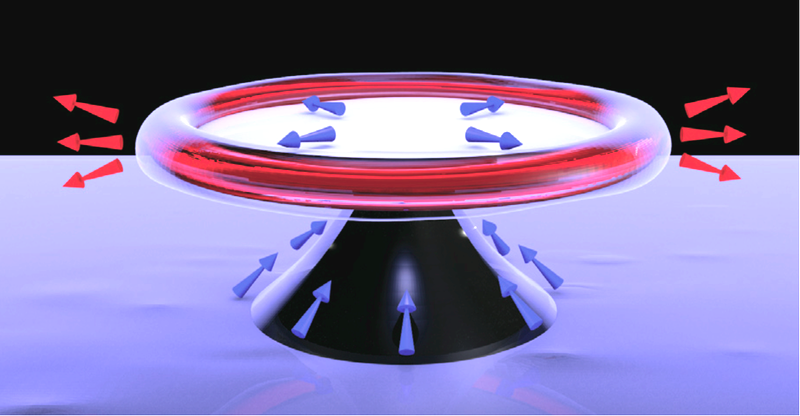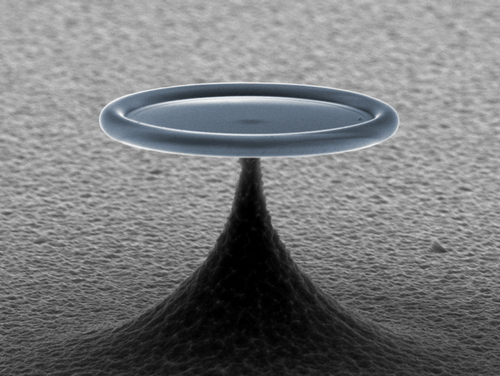Superfluid Increases Force of Laser Light
Lasers can generate forces in microscopic systems, such as for mechanical control of nanodevices or manipulation of bits of quantum information. A team of researchers has now demonstrated a new technique for creating a mechanical force using a laser, through the evaporation of superfluid helium. The force is 10 times greater than other methods can achieve in the cryogenic regime and could be used to cool tiny mechanical oscillators that act as detectors of minute forces or as experimental systems for studying their quantum states of motion.
Light can apply a force directly through radiation pressure or indirectly through a photothermal effect in which absorbed optical energy heats a material and causes it to expand. At room temperature, photothermal forces are the strongest available option, but at temperatures close to absolute zero, thermal expansion coefficients become very small. For investigations of quantum and other phenomena that require cryogenic conditions, researchers have had to rely on radiation pressure alone to induce tiny forces.
Seeking a better option, Chris Baker and his colleagues at the University of Queensland in Brisbane, Australia, came up with a way to take advantage of the superfluid property of liquid helium, which appears below a temperature of about 2 K. Since a temperature differential induces frictionless convection in liquid helium, they realized that laser heating could generate a force from the flow of the superfluid.
To demonstrate the technique, the team created a silica disc 75 micrometers in diameter with a toroidal ring, 7 micrometers thick, around its circumference. This microtoroid, supported by a slender silicon pedestal, acted as an optical cavity with resonances that could be excited by laser light.
The researchers then placed the microtoroid assembly inside a cryostat chamber containing a small amount of gaseous helium. On cooling, the gas condensed into a thin film of superfluid helium that coated the device. Laser light entered the cryostat through an optical fiber and heated the microtoroid, causing liquid helium to flow up the pedestal and across the disk to the ring. There it evaporated, and the recoil of the departing molecules generated an inward radial force.
By varying (modulating) the laser intensity, the researchers created a periodic radial force that vibrated the microtoroid. They used a modulation frequency of 1.35 MHz, chosen to excite a simple oscillation of the toroid and disc assembly, with the disc alternately deforming upward and downward, like the simplest vibration mode of a drumhead. The team calculated that the laser light should drive vibration of the device most efficiently if modulated at 40 MHz, but they found that frequencies above 2 MHz failed to excite any vibration, most likely because the induced flow velocities in the helium film were then so high that they caused superfluidity to break down.
The team also measured the vibration of the toroid due to radiation pressure alone, when the system was held above the superfluid transition temperature. They estimated that the force created by the superfluid evaporation mechanism was about 11 times higher than the radiation pressure force.
The researchers then refined the system so that they could modulate the laser light out of phase with the vibrations of the toroid. In this way they were able to monitor the toroid’s thermal vibrations and apply a superfluid evaporation recoil force that damped them to the point that the toroid contained only about 2000 phonons, the quantum units of vibration in a solid. By changing the shape of the object so that it couples more efficiently to the optically induced force, the researchers say that the number of phonons could be reduced much further, to one or less. Baker says that in such highly controlled conditions the device could serve as a platform for studying phonon physics.
The team suggests that the technique could be used to excite vibrations in mechanical oscillators with a wide variety of designs. That aspect of the work is what’s most intriguing, says Jack Harris of Yale University. Existing optomechanical methods produce simple harmonic motions in resonant devices, but “the motion of fluids offers a much richer range of possibilities,” says Harris. He believes that the versatility of a fluid-based system, along with the “surprising power” of the vibrations, means that the new technique “will definitely be a powerful one” for future experiments.
This research is published in Physical Review X.
–David Lindley
David Lindley is a freelance science writer, now retired. His most recent book is The Dream Universe: How Fundamental Physics Lost Its Way (Penguin Random House, 2020).







